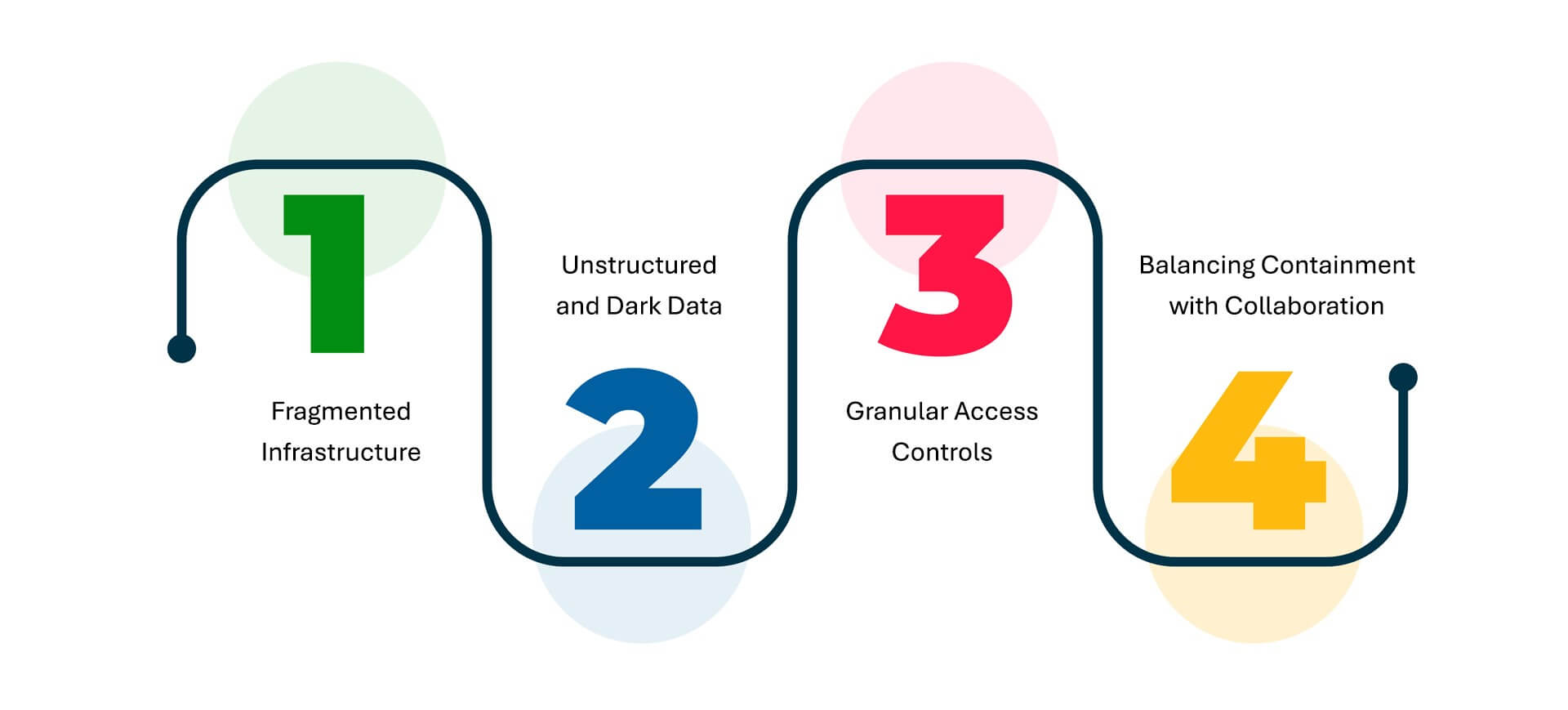What is Data Containment?
Data containment refers to the strategic practice of restricting, isolating, and controlling the movement, access, and proliferation of data—especially sensitive or regulated information—within defined boundaries. It is a core component of modern data security, governance, and compliance strategies, helping enterprises mitigate risks such as data leakage, regulatory violations, and internal misuse.
At its essence, data containment ensures that data stays where it should, moves only when necessary, and is handled only by those authorized to do so. It supports principles like least privilege, zero trust, and data minimization by reducing the surface area for exposure while increasing accountability.
Why Data Containment Matters in 2025
In an era where data is everywhere, data containment is becoming more critical than ever. Hybrid and multi-cloud environments, global data flows, and AI-driven processing pipelines have made the data landscape increasingly porous. Without intentional containment, organizations risk data sprawl, shadow access, non-compliance, and uncontrolled AI model inputs.
Enterprises today are rethinking perimeter-based security models. With sensitive information—PII, PHI, IP—flowing across collaboration platforms, SaaS apps, and edge devices, the new priority is containment over control. That means limiting where data can live, who can interact with it, and how it behaves across distributed architectures.
As regulations like GDPR, CCPA, DPDP, and HIPAA mandate stricter data localization, access logging, and usage transparency, data containment becomes not just a best practice—but a legal and ethical imperative.
Common Use Cases for Data Containment
- Ransomware Response: Isolating infected systems or datasets to prevent malware spread and enable forensic analysis.
- AI Model Guardrails: Ensuring sensitive or regulated data is not ingested into training pipelines, preserving explainability and compliance.
- Cross-Border Compliance: Enforcing geographic boundaries for regulated data under localization mandates or international transfer restrictions.
- Insider Risk Management: Preventing lateral movement of sensitive data by limiting access to authorized users, roles, or departments.
- Cloud Segmentation: Ensuring workloads and data remain in approved cloud zones, reducing risks in multi-cloud or hybrid deployments.
Challenges in Data Containment – and What Enterprises Must Do

Fragmented Infrastructure
With data scattered across on-prem systems, cloud providers, edge devices, and shadow IT, consistent containment policies are hard to enforce.
What to do:
Adopt unified data governance platforms that provide real-time visibility and policy-based control across environments.
Unstructured and Dark Data
Data that is uncategorized, unused, or unknown creates major blind spots in containment strategies.
What to do:
Use AI-driven discovery tools to identify, classify, and monitor data at rest and in motion—especially in email, shared drives, and legacy systems.
Granular Access Controls
Over-permissioned systems increase the risk of unintentional data spread or misuse.
What to do:
Implement role-based access controls (RBAC), attribute-based access controls (ABAC), and real-time policy enforcement that adapts to user behavior and data sensitivity.
Balancing Containment with Collaboration
Locking data down can hinder innovation and productivity if not carefully managed.
What to do:
Design containment policies that are dynamic, context-aware, and embedded into user workflows—empowering teams to work securely without compromising agility.
Containment Is the New Perimeter: Data Control in the Age of AI and Digital Sovereignty
As AI matures and data sovereignty becomes non-negotiable, enterprises are realizing that data containment is no longer a defensive maneuver—it’s a strategic foundation for trust, compliance, and resilience. In a world where data flows faster than it can be governed, containment becomes the control layer that travels with the data itself.
AI systems thrive on data, but they also amplify risk. Without guardrails, models can ingest sensitive, unvetted, or non-compliant data, leading to privacy breaches, regulatory violations, and ethical blind spots. Data containment acts as a safeguard—ensuring only the right data is accessed, processed, and shared within defined boundaries.
Meanwhile, sovereign cloud mandates and cross-border data transfer restrictions are forcing organizations to rethink how data is stored and used—especially in healthcare, finance, and defense. Containment supports jurisdictional control, enabling organizations to meet in-country requirements while maintaining operational agility.
And in the Zero Trust era, where trust is never implicit and access must be verified continuously, data containment replaces outdated perimeter-based thinking. Instead of securing the system, enterprises are securing the data—embedding controls that restrict how it moves, who can touch it, and what it can do.
In short, data containment is no longer a nice-to-have. It’s the operating principle for ethical AI, regulatory resilience, and enterprise control in a boundaryless digital world.
Data containment is no longer a reactive security tactic—it’s a proactive business enabler. It empowers enterprises to innovate with confidence, comply with global mandates, and protect what matters most. In a landscape defined by AI acceleration, cyber volatility, and regulatory scrutiny, those who contain their data will contain their risk—and their future.
Getting Started with Data Dynamics:
- Learn about Unstructured Data Management
- Schedule a demo with our team
- Read the latest blog: Sovereign AI and the Future of Nations: Why Data, Infrastructure, and Intelligence Must Align






